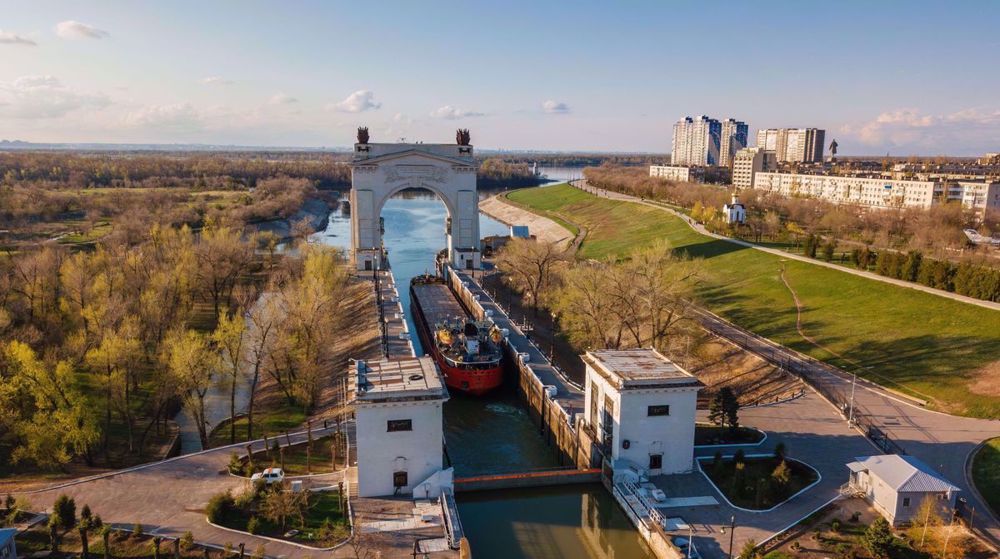Russia and Iran are building a new transcontinental trade route that is beyond the reach of any foreign intervention.
Both countries are subject to Western sanctions that have prompted them to turn toward each other and look eastward.
The new 3,000–kilometer passage stretches from the eastern edge of Europe to the Indian Ocean, along rivers and railways that are linked by the Caspian Sea.
Bloomberg News said Iran and Russia are spending billions of dollars to speed up delivery of cargoes through the passage.
“The goal is to shield commercial links from Western interference and build new ones with the giant and fast–growing economies of Asia,” it said.
“This is about establishing sanctions–proof supply chains all the way through,” Maria Shagina, an expert on sanctions and Russian foreign policy at the London–based International Institute for Strategic Studies, told the US financial news provider.
The most prominent thing about the emerging trade corridor is its advantage over traditional routes which are thousands of kilometers longer.
At its northern end is the Sea of Azov which – President Vladimir Putin said earlier this month – “has become an inland sea” for Russia. It is bracketed by the Crimean Peninsula and the mouth of the River Don.
From there river, sea and rail networks extend to Iranian hubs on the Caspian Sea and ultimately the Indian Ocean.
Russia is finalizing rules that would give ships from Iran right of passage along inland waterways on the Volga and Don rivers, according to Iran’s Maritime News Agency.
Last month, the Mehr News Agency reported that a first 12 million–ton shipment of Russian grain bound for India has already transited Iran.
According to Bloomberg, trade flows could increase if Iran manages to connect the unfinished and Chabahar Port complex on the Indian Ocean to its long–distance train network.
India has invested in the project, seeing Chabahar as a stepping stone in its bid to become a regional infrastructure developer and expand trade with Afghanistan and other Central Asian states as well as the region beyond.
In September, President Putin underlined the need to develop the ship, rail and road infrastructure along the route.
The route, he said, “will provide Russian companies with new opportunities to enter the markets of Iran, India, the Middle East and Africa, and will facilitate supplies from these countries in return”.
According to Shagina’s estimates, Russia and Iran are investing as much as $25 billion in the inland trade corridor.
The two countries have announced a raft of new business deals that cover goods including turbines, polymers, medical supplies and automotive parts.
Russia, Bloomberg said, needs to compensate for the sudden breakdown of its commercial ties with Europe, which before the Ukraine war was its biggest trade partner, as well as finding workarounds for US and European Union sanctions.
Iran’s geographical location allows Russia to safely transport goods via the trade corridor through Iranian territory all the way to Asia and India without incurring the risk of Western sanctions, it added.
Head of the Russian Chamber of Commerce and Industry Sergey Katyrin said trade with Iran is “a logistical bridge” between Russia and the Middle East, as well as South and Southeast Asia.
Trade between Russia and Iran has surged this year, with turnover exceeding $4 billion over January-October 2022 and is expected to surpass $5 billion by the end of the year, according to Russia’s Federal Customs Service. Russian exports to Iran have so far jumped by 27% versus last year, while imports are up 10%.
Katyrin told a conference in Tehran last month that there’s a “clear path” to reaching $40 billion once a free–trade agreement is in place.
In July, Iran’s Shana news agency said the National Iranian Oil Company (NIOC) and Russia’s Gazprom had signed a “historic” deal worth $40 billion for joint investment in oil and gas projects.
Last month, the Islamic Republic of Iran Shipping Lines Group (IRISL) made a $10 million investment in a port along the Volga, the Iranian Labor News Agency reported.
The aim, it said, is to almost double cargo capacity at the Solyanka Port in the Russian city of Astrakhan, to 85,000 tons a month.
The new corridor is a boost to a concerted effort among Iran, Russia and China to knit together the whole Eurasian territory.
China and Russia are already members of the Shanghai Cooperation Organization, an economic–security body that is making Iran its ninth member.
China and Iran are both close to gaining membership in the Eurasian Economic Union, which will make free trade across the countries possible.
Another institution that links economies in the region and beyond it is the BRICS group. Initially made up of Brazil, Russia, India and China, it now also includes South Africa and is poised to expand further.







